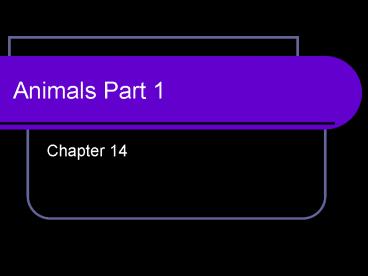Animals Part 1 - PowerPoint PPT Presentation
1 / 10
Title:
Animals Part 1
Description:
Vertebrates have a skull and backbone to protect most of the nervous system. ... b. Warning coloration-bright designs. c. Threatening appearance-horns, toxins ... – PowerPoint PPT presentation
Number of Views:42
Avg rating:3.0/5.0
Title: Animals Part 1
1
Animals Part 1
- Chapter 14
2
(No Transcript)
3
A. 6 Characteristics of Animals
- All animals are multicellular eukaryotic and do
not have cell walls. - All animals are consumers.
- All animals have specialized parts, such as
tissues and organs.
4
6 characteristics (continued)
- 4. Most animals reproduce sexually using sex
cells, sperm and egg. - 5. Most animals develop from embryo, an organism
in its earliest stage of development. - 6. Most animals can move from place to place and
are active in search of food.
5
B. Vertebrate vs. Invertebrate
- Animals have a nervous system to help them
respond to their environment - Vertebrates have a skull and backbone to protect
most of the nervous system. - Invertebrates lack a skull and backbone but make
up most of the animals on Earth.
6
C. Animal Behavior
- 1. Every animal species has adapted to their
surroundings to obtain the most food using the
least amount of energy. - 2. Animals have adapted ways to protect
themselves from predators - a. Camouflage-blending with background
- b. Warning coloration-bright designs
- c. Threatening appearance-horns, toxins
7
(No Transcript)
8
D. Animal Smarts
- Sometimes animals instinctively know what to do,
but sometimes they learn. - Behavior that does not depend on learning or
experience is innate behavior. - Learned behavior is behavior that has been
learned from experiences or from observing other
animals.
9
F. Seasonal Behavior
- 1. Migration is traveling from one place to
another to find food, water and shelter. - 2. Hibernation is a period of inactivity and
decreased body temperature that some animals
experience in winter. - 3. Estivation is a period of decreased activity
in the summer. - 4. Daily cycles called circadian rhythms can be
controlled by a biological clock.
10
G. Living together
- Social behavior is the interactions between
members of the same species. - It relies on communication
- pheromoeschemical communication
- Courtshipa dance, or home building
- Territoryget out of my space
- Sight, sound, smell
- Groups provide protection and competition.































